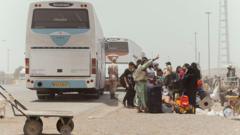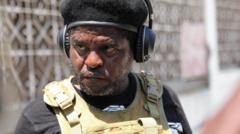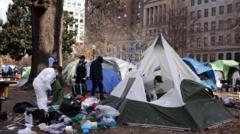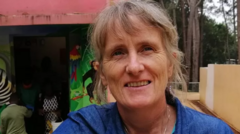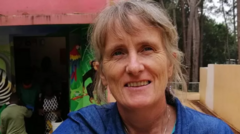As crime and gang violence ravage Cape Town’s townships, parents like Sibahle Mbasana feel compelled to enroll their children in former white-only schools, despite the lengthy commutes. This shift underscores the continued educational inequities stemming from apartheid, with parents in search of safer environments for their children, even as they confront the challenges of long travel times.
Parents in Cape Town Opt for Long Commutes to Safer Schools Amid Safety Concerns

Parents in Cape Town Opt for Long Commutes to Safer Schools Amid Safety Concerns
Safety fears in Cape Town's townships are driving families to send their children to former white-only schools, far away from their homes, due to violence and crime in local institutions.
Fears of crime and gang violence plaguing the outskirts of Cape Town are leading some parents to make the difficult choice of enrolling their children in former white-only schools, resulting in long and arduous daily commutes. Sibahle Mbasana, mother of three, recounted the daily threats her sons experienced at their local township school in Khayelitsha, Cape Town's largest township, where armed thugs threatened teachers and students alike. She emphasized the lack of security and the inability of school officials to protect the children against these intrusions.
Despite the end of apartheid more than three decades ago, the legacy of educational inequality persists, as black children continue to face significant obstacles. The Bantu Education Act of 1953 established segregated schooling that denied black students equal access to quality education, and as a result, many township schools remain overcrowded and underfunded. Mbasana transferred her children to a state school in Simon’s Town, located approximately 40 kilometers away, which offers better facilities and smaller class sizes.
Parents like the Mbasanas express a yearning to escape the township life, where safety concerns are compounded by poverty, limiting many families' options. Their current circumstances often leave them trapped in dangerous environments, where expressing a desire for better opportunities is met with frustration due to financial constraints.
While there are dedicated teachers making strides in the township schools, they face overwhelming challenges, including the presence of gangs demanding extortion fees from educators. Reports indicate that teachers at some schools no longer feel safe due to threats from armed gangs. In response, the Western Cape Education Department has implemented measures like hiring private security and increasing police patrols around schools.
However, these longer commutes to safer schools introduce new dangers. Mbasana shared the exhausting routine her children adhere to, waking up around 4:30 am and returning home around 4:30 pm, often falling tiredly asleep before finishing their homework. The physical and mental stress from these long hours of travel affects their performance, contributing to tiredness during school hours.
Lifalethu Mbasana's experience last year, when he was forced to walk home alone due to transport issues, further highlighted the vulnerabilities faced by township students. His story garnered national attention and underscored the challenges children confront daily commuting to education once designated exclusively for white students.
The educational landscape in South Africa remains deeply skewed, with societal and racial factors playing dominant roles in determining school access and quality. Schools in wealthier suburbs often enroll students from townships, resulting in the depletion of resources for local schools, which struggle to provide quality education amid increasing class sizes and diminishing teaching staff due to budget cuts.
Critics argue that the mismanagement of funds and continued neglect of township schools point to systemic issues rooted in historical injustices. Parents, frustrated by the unstable environment, echo a universal desire for safer, more equitable educational opportunities for their children.
As some families like the Mbasanas make tough choices in pursuit of a brighter future for their children, the broader narrative raises questions about the long-term impacts of historical educational inequities on South Africa’s youth.



